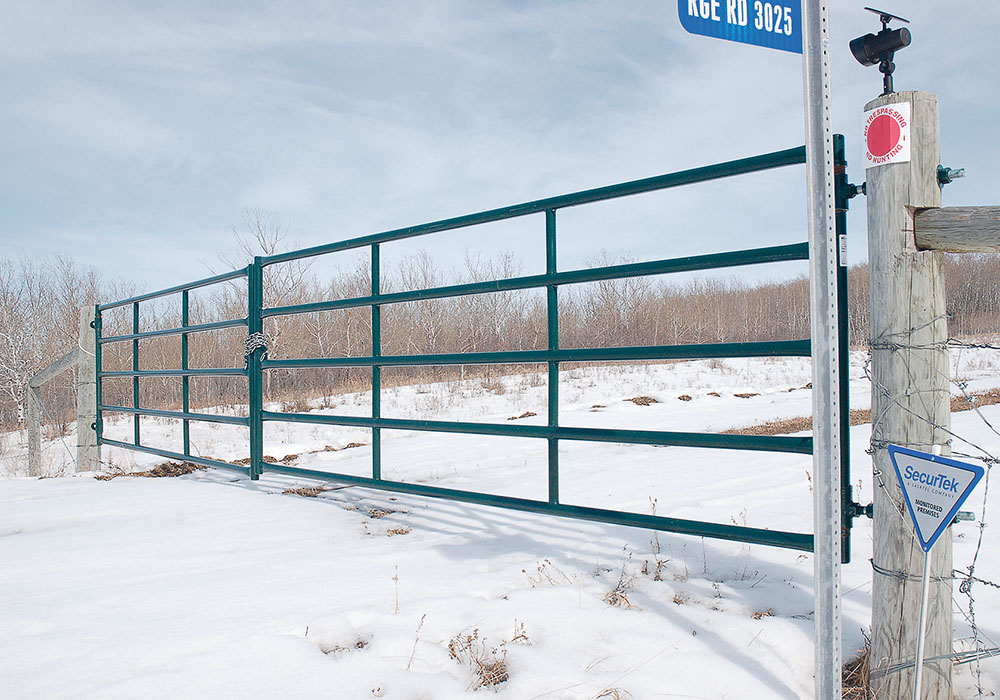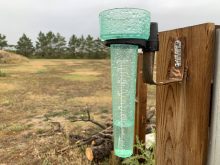Farmers are encouraged to make their property less inviting to criminals — starting with a closed gate
Rural crime increased dramatically on the Prairies during the economic downturn that started in 2017, so it’s likely a good idea for farmers to revisit their security with a pandemic pummelling the economy.
In 2018, the Alberta RCMP produced a video series about crime prevention through environmental design (CPTED) and target hardening.
RCMP Const. Julian Celms of Alberta, who hosted the video series, said it was meant to provide rural property owners simple suggestions that lessen the likelihood that thieves will choose their property to violate.
Read Also

AgCanadaTV: Your Agriculture News Recap for Oct. 17, 2025
https://youtu.be/GevFlt7b2-U U.S. bill could keep out Canadian truck drivers A bill tabled in the U.S. house of representatives this month would keep…
“CPTED is changing the environment around you to make it less inviting for the potential bad guys to victimize you, while target hardening are the steps to take to make it more difficult to break in and take your stuff,” said Celms.
He participated in rural crime investigations and has seen first hand how simple changes to a property can cause criminals to choose a different location to target.
Maybe the most obvious CPTED element is to keep a gate up, which Celms has seen to be effective.
“Before they (people who installed a gate) had it people would come in and give a fictitious story of why they were on the property, and the property owners would have to take a second to figure that out,” Celms said.
“Where as if you have a gate across the front of your property, ‘well, why are you here, I didn’t invite you in?’ ”
He said it’s a good idea to keep the gate closed all the time because if you only close it when you’re away it telegraphs to potential burglars when you’re not home.
Having a family name displayed to the public can also be a bad idea because some criminals can use social media to find out when owners are away from home.
For instance, if someone posts when they are on vacation or even in town watching their children’s hockey game, this could provide a time signal for someone to steal your stuff.
Post pictures on social media once you are home.
While we’re on social media, it’s probably wise to play your cards close to your chest and refrain from posting pictures of valuable property that may entice potential thieves.
Celms said CPTED focuses on creating an environment that makes criminals feel uncomfortable, such as clear sight lines from the house to the where people are most likely to enter the property.
“People may have shrubs in the front yard that may look really beautiful, but if you can’t see your driveway from your front door because of the shrubs, that may not be a really great choice,” Celms said.
Clear sight lines to probable targets, such as fuel stations, equipment and shops, will make thieves feel exposed, especially when strategically placed lights are installed.
“Improve some lighting, that’s usually the most cost effective thing you can do to secure your place,” Celms said.
“With solar powered LED lights, you don’t have to run as many wires as you would have had to 15 years ago.”
Gravelled areas are much louder to walk on compared to grass or paving stones, so a few patches or paths around the house can help you hear intruders.
“Gravel in parts of your property can be useful off the main path,” he said.
“If someone crosses the gravel, your dog or yourself are more likely to hear the gravel then if it was grass.”
Planting dense or sharp vegetation around the bottom of windows can deter people from using the window as a point of entry.
“Put roses underneath your windows,” Celms said.
“Roses prevents people from looking in, or if they want to choose that window as an entry point, it’s the last way you’d want to approach that property.”
Celms said some thieves identify a time when the property is likely to be unoccupied, but most of the rural robberies he’s witnessed can be classified as opportunistic.
This is why it’s important to keep the property looking as though it’s busy, especially the front lane.
For instance, if you’re leaving your property for a few days in the winter, have someone drive on your lane if there is a snowfall.
“Someone driving down a rural road can see a property that hasn’t seen activity in a little while,” Celms said.
“A number of times I’ve been to a break and enter and it’s over Christmas or over a holiday, they’ve been gone for a week and nobody attended to their driveway.”
He said it’s best to use layers of defences to protect a property, and strategically placed cameras can both deter thieves and help identify who is coming into your yard.
“If all you see is a blob on the north side of your property, it doesn’t do a whole lot,” Celms said.
“If you had an interesting lawn ornament at the front of your property that is situated so that when you drive down the property it has a camera focused on waist level towards where you drive and capture a license plate in a hidden fashion, like a trail cam, that can be super effective at catching what cars come into your property.”
Doorbell cameras can also be an effective way to see if someone is trying to scope out your property.
Celms said he’s seen footage of people who entered a property under the guise of dropping off pamphlets, but the doorbell camera caught them trying to see what was in the house through the door window.
“Door cams are great because you get a sense of who is there. They often know they are being observed, so they are going to change their behaviour based on that,” Celms said.
“You can even get a text or notification that there is someone at your front door.”
Another CPTED element is to make sure your property has clear boundaries, so that if someone enters, it can’t be explained as an accidental intrusion and it’s clear they are intentionally trespassing.
Property should also be arranged so that enticing targets aren’t visible from the road so that potential criminals have nothing that grabs their attention when driving by.
Celms said fuel is one of the most common targets because thieves are often running stolen vehicles and don’t want to get fuel at a gas station where there are cameras.
“They’re after things they can easily resell. Some have a network to hawk an ATV or snowmobile, but they are looking for things they can take to a pawn shop,” Celms said.
“Tools, compressor, bikes, or they will look for anything in a brand new box so they can make up a story on and sell it on Kijii.”
He said it’s a good idea to make identification marks on your property and take pictures of the serial numbers so that you’ll have a better chance of getting it back.
“When something goes missing, every police officer across the country has access to the same database. So when we stop a vehicle that has some suspicious guys in it and we see some obvious things that because of the totality of the circumstances we think property in their possession is hot, when we run some of these serial numbers, if they come back as a hit, great, we can arrest them right there.”
Police can’t prove the property is stolen if identifying marks or serial numbers are available for police to work with, and thieves may be able to keep the property.
“Even if we have other information that points us towards a suspect, it’s really difficult for us to action that when there is nothing unique that ties the owner to the property,” Celms said.
He said garages or parked cars are usually the first things thieves target.
“Nine times out of 10 the bad guys don’t want a confrontation, which is why there is a lot of activity on outbuildings. When you break into someone’s house there is a greater punishment than if you break into someone’s garage or business.”
He said target hardening is securing your property by putting in an effective lock on your door, putting glaze on your windows so that if you break the window it doesn’t shatter, putting a hockey stick on your sliding back patio door, or changing doors so that they open out and are much harder to kick in.
If property owners do come across someone trying to steal their property, Celms said it is likely a good idea to execute a prearranged lockdown mode plan.
“First thing you want to do is call the police and get into a position where you are going to be safe. Leave the confrontation to the police because you don’t know what that person has,” Celms said.
“You can protect yourself, absolutely you can, but if you have the option of being safe, take that route first.”
















